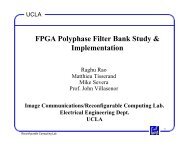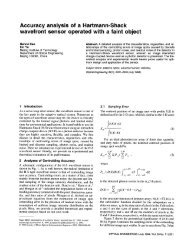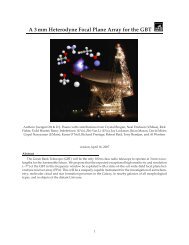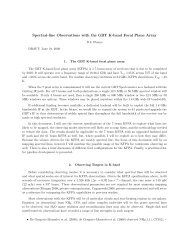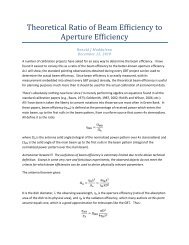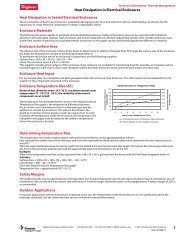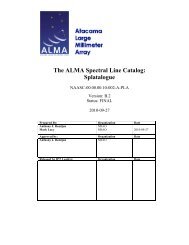Cryogenic Adsorption of Low-Concentration Hydrogen on Charcoal ...
Cryogenic Adsorption of Low-Concentration Hydrogen on Charcoal ...
Cryogenic Adsorption of Low-Concentration Hydrogen on Charcoal ...
You also want an ePaper? Increase the reach of your titles
YUMPU automatically turns print PDFs into web optimized ePapers that Google loves.
<str<strong>on</strong>g>Cryogenic</str<strong>on</strong>g> <str<strong>on</strong>g>Adsorpti<strong>on</strong></str<strong>on</strong>g> <str<strong>on</strong>g>of</str<strong>on</strong>g> <str<strong>on</strong>g>Low</str<strong>on</strong>g>-<str<strong>on</strong>g>C<strong>on</strong>centrati<strong>on</strong></str<strong>on</strong>g> <str<strong>on</strong>g>Hydrogen</str<strong>on</strong>g> <strong>on</strong><br />
<strong>Charcoal</strong>, 5A Molecular Sieve, UOP S-115,ZSM-5 rand Wessalith DAY<br />
R. Scott Willms<br />
Los Alamos Nati<strong>on</strong>al Laboratory<br />
Los Alamos NM 87545<br />
ABSTRACT<br />
The separati<strong>on</strong> <str<strong>on</strong>g>of</str<strong>on</strong>g> low-c<strong>on</strong>centrati<strong>on</strong> hydrogen isotopes from<br />
helium is a processing step that is required for ceramic lithium<br />
breeding blanket processing. <str<strong>on</strong>g>Cryogenic</str<strong>on</strong>g> adsorpti<strong>on</strong> is <strong>on</strong>e<br />
method <str<strong>on</strong>g>of</str<strong>on</strong>g> effecting this separati<strong>on</strong>. In this study five<br />
adsorbents were c<strong>on</strong>sidered for this purpose: charcoal, SA<br />
molecular sieve, UOP S-115,ZSM-5 and Wessalith DAY. The<br />
first two adsorbents exhibit good equilibrium loadings and are<br />
shown to be quite effective at adsorbing low-c<strong>on</strong>centrati<strong>on</strong><br />
hydrogen isotopes. The latter three adsorbents display<br />
c<strong>on</strong>siderably lower equilibrium loadings. This study c<strong>on</strong>cludes<br />
that by using either charcoal or SA molecular sieve, cryogenic<br />
adsorpti<strong>on</strong> would be an effective means <str<strong>on</strong>g>of</str<strong>on</strong>g> separating hydrogen<br />
isotopes from helium.<br />
INTRODUCTION<br />
One <str<strong>on</strong>g>of</str<strong>on</strong>g> the tritium breeding blankets that has been c<strong>on</strong>sidered<br />
for fusi<strong>on</strong> machines is comprised <str<strong>on</strong>g>of</str<strong>on</strong>g> lithium ceramic. To<br />
remove tritium from such a blanket, a stream <str<strong>on</strong>g>of</str<strong>on</strong>g> helium<br />
c<strong>on</strong>taining 0.1-1% % is swept over the ceramic. The %<br />
exchanges with tritium in the ceramic, thus moving the<br />
tritium into the helium sweep gas. Once outside the blanket<br />
the tritium must be separated from the helium carrier. One<br />
method c<strong>on</strong>sidered for this purpose is cryogenic adsorpti<strong>on</strong><br />
which would collect all <str<strong>on</strong>g>of</str<strong>on</strong>g> the hydrogen isotopes and leave<br />
helium in the gas phase. The helium is available for recycle<br />
back to the breeding blanket. When saturated with hydrogen<br />
isotopes, the cryogenic adsorbent is regenerated, sending the<br />
liberated hydrogen isotopes to the fuel processing system and<br />
ultimately to reuse in the fusi<strong>on</strong> machine.<br />
To dem<strong>on</strong>strate the separati<strong>on</strong> <str<strong>on</strong>g>of</str<strong>on</strong>g> low-c<strong>on</strong>centrati<strong>on</strong> hydrogen<br />
isotopes from helium, five adsorbents were c<strong>on</strong>sidered:<br />
coc<strong>on</strong>ut charcoal, Linde 5A molecular sieve, UOP S-115,<br />
ZSM-5 and Wessalith DAY. All <str<strong>on</strong>g>of</str<strong>on</strong>g> these materials are<br />
commercially available. <strong>Charcoal</strong> and molecular sieve have<br />
been used extensively in tritium processing for applicati<strong>on</strong>s<br />
such as cryosorpti<strong>on</strong> vacuum pumps, for separati<strong>on</strong> <str<strong>on</strong>g>of</str<strong>on</strong>g><br />
impurities (water, methane, nitrogen, etc.) from hydrogen<br />
isotopes, and for collecti<strong>on</strong> <str<strong>on</strong>g>of</str<strong>on</strong>g> water in tritium effluent<br />
cleanup systems. Because <str<strong>on</strong>g>of</str<strong>on</strong>g> extensive tritium processing<br />
experience with these two materials, they were obvious<br />
choices for inclusi<strong>on</strong> in this study.<br />
UOP S-l15,ZSM-5 and Wessalith DAY are molecular sieves<br />
(aluminosilicates), but differ from 5A molecular sieve in that<br />
they have had all or most <str<strong>on</strong>g>of</str<strong>on</strong>g> the Al eliminated from the<br />
This work supported by the US DOE Office <str<strong>on</strong>g>of</str<strong>on</strong>g> Fusi<strong>on</strong> Energy.<br />
0-7803-14 12-3$04.0001994IEEE<br />
61<br />
molecular sieve. This gives them the unique property <str<strong>on</strong>g>of</str<strong>on</strong>g><br />
being hydrophobic rather than hydrophilic as is typical <str<strong>on</strong>g>of</str<strong>on</strong>g><br />
most molecular sieves;. This property is attractive because it<br />
would minimize or eliminate a small, semipermanent tritium<br />
inventory <strong>on</strong> the adsorbent in the water form which is<br />
expected for 5A molecular sieve.<br />
A test stand for measuring the adsorpti<strong>on</strong> characteristics <str<strong>on</strong>g>of</str<strong>on</strong>g><br />
these materials was c<strong>on</strong>structed. Streams <str<strong>on</strong>g>of</str<strong>on</strong>g>various<br />
c<strong>on</strong>centrati<strong>on</strong>s <str<strong>on</strong>g>of</str<strong>on</strong>g> H2 iin He were passed through the liquid<br />
nitrogen-cooled adsorbent. Breakthrough w es were<br />
observed using gas chromatography. From these data<br />
adsorpti<strong>on</strong> isotherms .were determined.<br />
A. Apparatus<br />
EXPERIMENTAL DESCRIPTION<br />
The experimental setup used for this study is shown in<br />
figure 1. Automatic flow c<strong>on</strong>trollers were used to mix<br />
hydrogen and helium in the desired ratios and flowrates.<br />
This mixture was sent to an adsorber which was immersed in<br />
a liquid nitrogen bath. The adsorber exit pressure was<br />
measured and c<strong>on</strong>trolled by a back pressure regulator valve<br />
which exhausted to atmosphere. Part <str<strong>on</strong>g>of</str<strong>on</strong>g> the exhaust was sent<br />
to an MTI gas chromatograph for analysis <str<strong>on</strong>g>of</str<strong>on</strong>g> the hydrogen<br />
c<strong>on</strong>centrati<strong>on</strong>.<br />
The adsorbers were c<strong>on</strong>structed <str<strong>on</strong>g>of</str<strong>on</strong>g> all-welded 50 cc Whitey<br />
sample cylinders (SS-4CD-TW-50). Outer cylinder<br />
dimensi<strong>on</strong>s are 13.45 cm l<strong>on</strong>g x 2.4 cm diameter. The wall<br />
thickness is 0.165 cm.. The cylinder was filled with a<br />
measured amount <str<strong>on</strong>g>of</str<strong>on</strong>g> adsorbent and both ends were packed<br />
with stainless steel wcd. 1/4" tubing was welded to both<br />
cylinder ends for c<strong>on</strong>necti<strong>on</strong> to the test stand.<br />
B. Procedures<br />
Before an experimenL.11 series, each bed was c<strong>on</strong>nected to the<br />
test stand and regenerated at 340 "C with a dry helium purge<br />
overnight. Between successive loadings (adsorber not<br />
disc<strong>on</strong>nected from the: test stand) the bed was regenerated at<br />
200 "C for 30 minutes. If there was any chance that the<br />
adsorbent had had c<strong>on</strong>tact with air (and, thus, water) the<br />
more aggressive regenerati<strong>on</strong> was repeated.
~<br />
Table 1<br />
5A Molecular Sieve Uni<strong>on</strong> carbide (Liide) Pellets 1/16"<br />
S-115 UOP s-115 Pellets 1/16"<br />
A run began by regenerating the adsorber and isolating it<br />
with its isolati<strong>on</strong> valves. It was then immersed in liquid<br />
nitrogen. The target h e l i e flow for the run was started<br />
through the bypass valve and the back pressure regulator set.<br />
At 'time Zero' the flow was rerouted through the adsorber<br />
and the bypass valve was closed. Simultaneously, GC<br />
sampling was started. Samples were collected and analyzed<br />
every 72 sec<strong>on</strong>ds. This was c<strong>on</strong>tinued until the hydrogen had<br />
completely broken through the adsorber (the exit<br />
c<strong>on</strong>centrati<strong>on</strong> was equal to the inlet c<strong>on</strong>centrati<strong>on</strong>).<br />
For all experiments the total pressure was c<strong>on</strong>trolled at<br />
790 torr (absolute).<br />
Nominally runs for each adsorbent were carried out with<br />
1000 sccm <str<strong>on</strong>g>of</str<strong>on</strong>g> He and various flowrates <str<strong>on</strong>g>of</str<strong>on</strong>g> H,.The H,<br />
flowrates were typically 1,2.5, 5, 10,25 and 50 sccm (see<br />
Table 2 for a listing <str<strong>on</strong>g>of</str<strong>on</strong>g> the actual c<strong>on</strong>diti<strong>on</strong>s used for each<br />
adsorbent).<br />
He<br />
the major cati<strong>on</strong> is Ca [3]. This makes for a highly polar,<br />
hydrophilic material. The 5A molecular sieve studied here<br />
was obtained from the Linde divisi<strong>on</strong> <str<strong>on</strong>g>of</str<strong>on</strong>g> Uni<strong>on</strong> Carbide. The<br />
pellets are formed with a clay binder which c<strong>on</strong>stitutes 20%<br />
<str<strong>on</strong>g>of</str<strong>on</strong>g> the pellet. The specific surface area is reported by Danner<br />
[2] to be 572 m2/gm.<br />
Molecular sieves have also been prepared with little or no Al<br />
resulting in a material which is n<strong>on</strong>-polar and hydrophobic.<br />
One class <str<strong>on</strong>g>of</str<strong>on</strong>g> de-aluminated molecular sieves are essentially<br />
pure silica and have a unique structure <str<strong>on</strong>g>of</str<strong>on</strong>g>ten referred to as<br />
silicalite. They have been discussed by various authors [4-<br />
101. The UOP S-115 and the ZSM-5 c<strong>on</strong>sidered here are<br />
silicalites. The specific surface areas <str<strong>on</strong>g>of</str<strong>on</strong>g> these materials are<br />
approximately 400 m2/gm. The Si:AI ratio for $115 is in<br />
the range <str<strong>on</strong>g>of</str<strong>on</strong>g> 140-200. It should be noted that both <str<strong>on</strong>g>of</str<strong>on</strong>g> the<br />
silicalites were prepared as pellets which means that they<br />
c<strong>on</strong>tain a binder. The ZSM-5 for instance c<strong>on</strong>tained<br />
c<strong>on</strong>siderable (35%) alumina as the binder.<br />
The Degussa Wessalith DAY is a de-aluminated Y structure<br />
molecular sieve. Its specific surface area is 800 m2/gm [ 111.<br />
H2<br />
BACK PRESSURE<br />
REGULATOR<br />
VENT<br />
RESULTS<br />
A. Breakthrough Curves<br />
Figure 1 Schematic <str<strong>on</strong>g>of</str<strong>on</strong>g> Experimental Setup<br />
C. Ahorbents<br />
The adsorbents used are summarized in<br />
Table 1. The charcoal used here is a Calg<strong>on</strong><br />
type PCB granular activated carb<strong>on</strong><br />
produced from coc<strong>on</strong>ut shells. Its specific<br />
surface area is about 1200 m2/gm [l].<br />
Molecular sieves are aluminosilicates with<br />
included cati<strong>on</strong>s such as sodium, potassium<br />
and calcium. The cati<strong>on</strong>s are required to<br />
balance the electrical charge <str<strong>on</strong>g>of</str<strong>on</strong>g> the<br />
aluminum atoms. For 5A molecular sieve<br />
there is an equal amount <str<strong>on</strong>g>of</str<strong>on</strong>g> Al and Si, and<br />
z70<br />
s 560<br />
.E 50<br />
x<br />
90<br />
-<br />
-1 -<br />
w 40<br />
._<br />
-<br />
330<br />
E<br />
620 -<br />
10<br />
Feed: 1 SLPM He and 50 s m H2 7 ,I,'*'s'- Total Pressure: 790 torr<br />
- +:"<br />
.<br />
- ;' 1<br />
A typical breakthrough curve is shown in figure 2. This<br />
particular run was for charcoal and used 1000 sccm <str<strong>on</strong>g>of</str<strong>on</strong>g>Me<br />
and 50 sccm <str<strong>on</strong>g>of</str<strong>on</strong>g> % in the feed. For 32 minutes no hydrogen<br />
1<br />
_ ___._........______.__..<br />
_. 50000<br />
0 10 20 30 40 50 60<br />
Time (Minutes)<br />
Figure 2 Typical Breakthrough Curve (<strong>Charcoal</strong>, 77 K)<br />
45000<br />
- 40000<br />
- 35000 -<br />
k<br />
- 30000 4<br />
._<br />
X<br />
- 25000<br />
B<br />
20000 ;<br />
- 15000 2<br />
10000<br />
5000<br />
62
~<br />
90<br />
80<br />
70<br />
g 60<br />
cs)<br />
2 50<br />
3<br />
cs)<br />
.E 40<br />
U m<br />
3 30<br />
20<br />
Lines are Langmuir Isotherms<br />
Silicalite<br />
A<br />
ZSM-5<br />
10<br />
0<br />
Jessalith Day<br />
,<br />
0 5 10 15 20 25 30 35 40<br />
H2 Partial Pressure (torr)<br />
Figure 3 77 K <str<strong>on</strong>g>Adsorpti<strong>on</strong></str<strong>on</strong>g> Isotherms for Five Adsoknts<br />
was detected in the adsorber exhaust. The GC is able to<br />
detect hydrogen in c<strong>on</strong>centrati<strong>on</strong>s greater than about 20 ppm.<br />
Thereafter, following a sigmoid curve, the hydrogen<br />
G<strong>on</strong>centrati<strong>on</strong> increases over a period <str<strong>on</strong>g>of</str<strong>on</strong>g> about 10 minutes,<br />
ultimately matching the feed hydrogen c<strong>on</strong>centrati<strong>on</strong>. This<br />
indicates that the bed has completely saturated.<br />
The l<strong>on</strong>g period <str<strong>on</strong>g>of</str<strong>on</strong>g> no in the exhaust followed by a<br />
relatively sharp breakthrough indicates that this material has<br />
a "favorable" adsorpti<strong>on</strong> isotherm (c<strong>on</strong>firmed below). It also<br />
indicates that the "unused" porti<strong>on</strong> <str<strong>on</strong>g>of</str<strong>on</strong>g> the bed is relatively<br />
small. See [3] for a discussi<strong>on</strong> <str<strong>on</strong>g>of</str<strong>on</strong>g> this adsorpti<strong>on</strong><br />
terminology.<br />
Integrati<strong>on</strong> <str<strong>on</strong>g>of</str<strong>on</strong>g> the difference between the amount <str<strong>on</strong>g>of</str<strong>on</strong>g> hydrogen<br />
in the adsorber inlet and outlet can be used to determine the<br />
cumulative bed loading at any instant. The results <str<strong>on</strong>g>of</str<strong>on</strong>g> this<br />
calculati<strong>on</strong> are shown <strong>on</strong> figure 2 (dashed line). The ultimate<br />
bed loading in this case was 87.7 SCC $/gm adsorbent.<br />
Coupled with the 37.6 torr partial pressure <str<strong>on</strong>g>of</str<strong>on</strong>g> $ over the<br />
bed, this run establishes <strong>on</strong>e point <strong>on</strong> the charcoal isotherm.<br />
B. <str<strong>on</strong>g>Adsorpti<strong>on</strong></str<strong>on</strong>g> Isotherms<br />
Table 2 summarizes all <str<strong>on</strong>g>of</str<strong>on</strong>g> the runs c<strong>on</strong>ducted. Besides<br />
listing the flowrates and partial pressures for each<br />
experiment, the results <str<strong>on</strong>g>of</str<strong>on</strong>g> the cumulative loading calculati<strong>on</strong>s<br />
are included.<br />
The informati<strong>on</strong> in Tablle 2 was used to prepare figure 3<br />
which shows <strong>on</strong> <strong>on</strong>e adsorpti<strong>on</strong> isotherm plot, all <str<strong>on</strong>g>of</str<strong>on</strong>g> the runs<br />
carried out. Each data set was fit with a Langmuir equati<strong>on</strong><br />
which is:<br />
where v is the amount adsorbed in STF' volumdgm <str<strong>on</strong>g>of</str<strong>on</strong>g><br />
adsorbent, v, is the m<strong>on</strong>olayer amount adsorbed, B is the<br />
Langmuir c<strong>on</strong>stant and p is the adsorbate partial pressure. It<br />
is apparent from figure 3 that this adequately models the<br />
data.<br />
As expected from the sharp breakthrough curves, all <str<strong>on</strong>g>of</str<strong>on</strong>g> the<br />
isotherms are "favorable" (sec<strong>on</strong>d derivative < 0). A<br />
summary <str<strong>on</strong>g>of</str<strong>on</strong>g> the Langmuir parameters for each adsorbent are<br />
given in Table 3.<br />
In the Langmuir model <str<strong>on</strong>g>of</str<strong>on</strong>g> adsorpti<strong>on</strong> the value <str<strong>on</strong>g>of</str<strong>on</strong>g> v,<br />
represents the ultimate lbed loading assuming that the surface<br />
<str<strong>on</strong>g>of</str<strong>on</strong>g> the adsorbent is saturated by a m<strong>on</strong>olayer <str<strong>on</strong>g>of</str<strong>on</strong>g> adsorbate.<br />
This is the asymptotic value to which v will increase. In<br />
Table 3, the fact that v,, varies from 103 to 24.2 scc/gm for<br />
the five adsorbents, may at least in part be attributed to<br />
variati<strong>on</strong>s in specific surface area and adsorpti<strong>on</strong> site density.<br />
Indeed, except for Wesyalith DAY, the values <str<strong>on</strong>g>of</str<strong>on</strong>g> v, are<br />
roughly proporti<strong>on</strong>al to the material's specific surface area.<br />
The very low loading viilues for Wessalith DAY are<br />
surprising c<strong>on</strong>sidering its large surface area.<br />
63
IA Sieve<br />
UOP s-115<br />
ZSM-5<br />
Wessalith<br />
Table 2<br />
Summary <str<strong>on</strong>g>of</str<strong>on</strong>g> Experiments C<strong>on</strong>ducted<br />
He H2<br />
Flowrpte Flowrate pm Y<br />
idsorbent (sccm) (sccm) (tOR) (Scdpm)<br />
3harcoal 1000 1<br />
.789 14.5<br />
1000 2.5 1.97 23.4<br />
1000 10 7.82 45.6<br />
1000 25 19.3 66.7<br />
1000 50 37.6 87.7<br />
1000 10<br />
2000 10<br />
2000 10<br />
4000 10<br />
8000 10<br />
1000 10<br />
1000 5<br />
4000 4<br />
8000 8<br />
1000 2.5<br />
1000 5<br />
1000 10<br />
1000 25<br />
1000 50<br />
1000 1<br />
1000 2.5<br />
1000 5<br />
1000 10<br />
1000 25<br />
1000 50<br />
1000 1<br />
1000 2.5<br />
1000 5<br />
1000 10<br />
1000 25<br />
7.82<br />
3.93<br />
3.93<br />
1.97<br />
0.99<br />
7.82<br />
3.93<br />
0.789<br />
0.789<br />
1.97<br />
3.93<br />
7.82<br />
19.3<br />
37.6<br />
.789<br />
1.97<br />
3.93<br />
7.82<br />
19.3<br />
37.6<br />
,789<br />
1.97<br />
3.93<br />
7.82<br />
19.3<br />
1000 50 37.6<br />
36.0<br />
26.0<br />
26.0<br />
14.5<br />
7.0<br />
36.0<br />
26.5<br />
8.4<br />
5.0<br />
2.7<br />
5.1<br />
8.7<br />
17.4<br />
27.0<br />
1.6<br />
3.5<br />
5.6<br />
9.1<br />
16.2<br />
23.1<br />
0.26<br />
0.44<br />
0.83<br />
1.5<br />
3.3<br />
5.8<br />
Of this group, charcoal is clearly the best adsorbent for<br />
separating H, from helium, though 5A molecular sieve also<br />
exhibits good performance. The three de-aluminated sieves<br />
show substantially poorer performance, with UOP S-115 and<br />
ZSM-5 showing comparable loadings and Wessalith DAY<br />
giving the worst loading figures.<br />
Table 3<br />
Summary <str<strong>on</strong>g>of</str<strong>on</strong>g> Langmuir Parameters for Each Adsorbent<br />
5A Molecular Sieve 0.149<br />
UOP s-115 0.0220<br />
0.0426<br />
CONCLUSIONS<br />
Five adsorbents have been tested for suitability at separating<br />
low c<strong>on</strong>centrati<strong>on</strong> H, from He. From equilibrium loading<br />
c<strong>on</strong>siderati<strong>on</strong>s the adsorbents can be ranked from best to<br />
worst as: charcoal, 5A molecular sieve, UOP S-115 E ZSM-5,<br />
and Wessalith DAY. Either <str<strong>on</strong>g>of</str<strong>on</strong>g> the first two materials would<br />
provide good performance for the subject applicati<strong>on</strong>.<br />
Though charcoal provides the best loading performance,<br />
there may be other c<strong>on</strong>siderati<strong>on</strong>s which would also influence<br />
the choice <str<strong>on</strong>g>of</str<strong>on</strong>g> adsorbmts such as stability, carb<strong>on</strong> c<strong>on</strong>tent and<br />
hydrophobichydrophic nature. This study indicates that<br />
cryogenic adsorpti<strong>on</strong> is a good means for separating lowc<strong>on</strong>centrati<strong>on</strong><br />
hydrogen isotopes from He. The isotherms<br />
presented here would be useful for the design <str<strong>on</strong>g>of</str<strong>on</strong>g> a practical<br />
adsorber.<br />
ACKNOWLEDGMENTS<br />
The author would like to gratefully acknowledge the work <str<strong>on</strong>g>of</str<strong>on</strong>g><br />
Richard Bart<strong>on</strong> (Teacher Research Associates Program) and<br />
Je<str<strong>on</strong>g>of</str<strong>on</strong>g>f Urioste (Graduate Research Assistant Program) who<br />
collected the experimental data. Mobil Research and<br />
Development Corporati<strong>on</strong> d<strong>on</strong>ated the ZSM-5, Degussa<br />
Corporati<strong>on</strong> d<strong>on</strong>ated the Wessalith DAY and UOP d<strong>on</strong>ated<br />
the S-115. Gratitude is expressed to these three corporati<strong>on</strong>s.<br />
REFERENCES<br />
Calg<strong>on</strong> Technical Bulletin<br />
RP. Danner, The <str<strong>on</strong>g>Adsorpti<strong>on</strong></str<strong>on</strong>g> <str<strong>on</strong>g>of</str<strong>on</strong>g>Binary Gashfixtures <strong>on</strong>Molecular<br />
Sieves, PkD. Dissertati<strong>on</strong>, Lehigh University, 1906, p. 27.<br />
RT. Yang, Gas Separati<strong>on</strong> by <str<strong>on</strong>g>Adsorpti<strong>on</strong></str<strong>on</strong>g> Processes, Butterworths,<br />
1987, pp 19-24.<br />
E.M. Flanigen, RW. Grose, "Crystalline Silica Adsorbent," US Patent<br />
4,061,724, 1977.<br />
E.M. Flanigen, J.M. Bennett, R W. GTose, J.P. Cohen, R.L. Patt<strong>on</strong>, R.M.<br />
Kirchner, J.V. Smith, "Silicalke, a New Hydrophobic Crystalline Silica<br />
Molecular Sieve,"Nafure, 271,512 (1978).<br />
G.T. Kokotailo, S.L. Lawt<strong>on</strong>, D.H. Ols<strong>on</strong>, W.M.J. Meier, "Structure <str<strong>on</strong>g>of</str<strong>on</strong>g><br />
Synthetic Zeolite ZSM-5," Nature, 272,437-438 (1978).<br />
RM. Dessau, "Selective sorpti<strong>on</strong> properties <str<strong>on</strong>g>of</str<strong>on</strong>g> zeolites," <str<strong>on</strong>g>Adsorpti<strong>on</strong></str<strong>on</strong>g> and<br />
I<strong>on</strong> Exchange ufth Synthetic Zeolites-Principles and Practice, W.H.<br />
Flank, Ed., ACS Symposium Series 135, Am. Chem. Soc., Washingt<strong>on</strong>,<br />
DC, 1980, pp 123-135.<br />
K. Otto, C.N. M<strong>on</strong>treuil, 0. Todor, R.W. McCabe, and H.S. Gandi,<br />
"<str<strong>on</strong>g>Adsorpti<strong>on</strong></str<strong>on</strong>g> <str<strong>on</strong>g>of</str<strong>on</strong>g> Hydrocarb<strong>on</strong>s and Other Exhaust Comp<strong>on</strong>ents <strong>on</strong><br />
Silicalite," AIChEJ., 30, 2333-2340 (1991).<br />
H. B. Abdul-Rehman, M. A Hasanain, and K.F. Loughlin, "Quatemary,<br />
Ternary, Binary, and Pure Comp<strong>on</strong>ent Sorpti<strong>on</strong> <strong>on</strong> Zeolites. 1. Light<br />
Alkanes <strong>on</strong> Lmde S-115 Silicalite at Moderate to High Pressures", I&EC<br />
Res.. 29. 1525-1535 (1990).<br />
[lo] C-K: Lee and AS.T. Chian& "Lattice Model for the <str<strong>on</strong>g>Adsorpti<strong>on</strong></str<strong>on</strong>g> <str<strong>on</strong>g>of</str<strong>on</strong>g><br />
Benzene in Silicalite I",AIChEJ., 38(1), 128-135 (1992).<br />
[ll] Degum Technical Bulletin, Degussa AG, Frankfurt 11, June 1991.<br />
64





